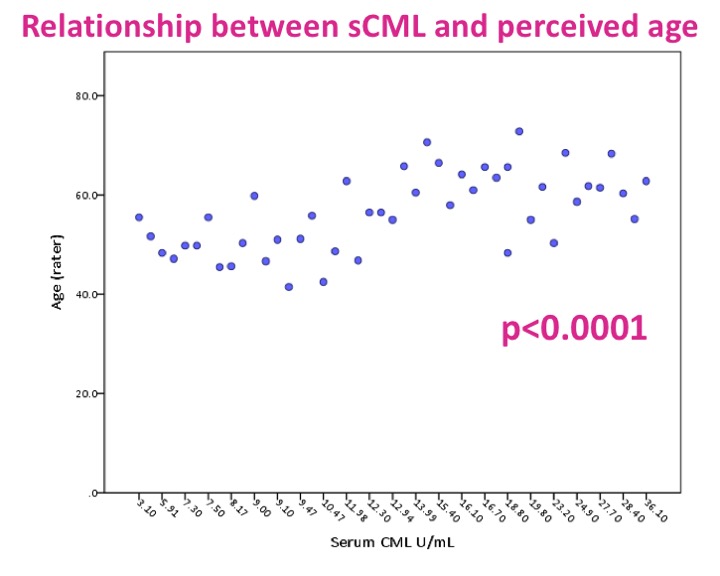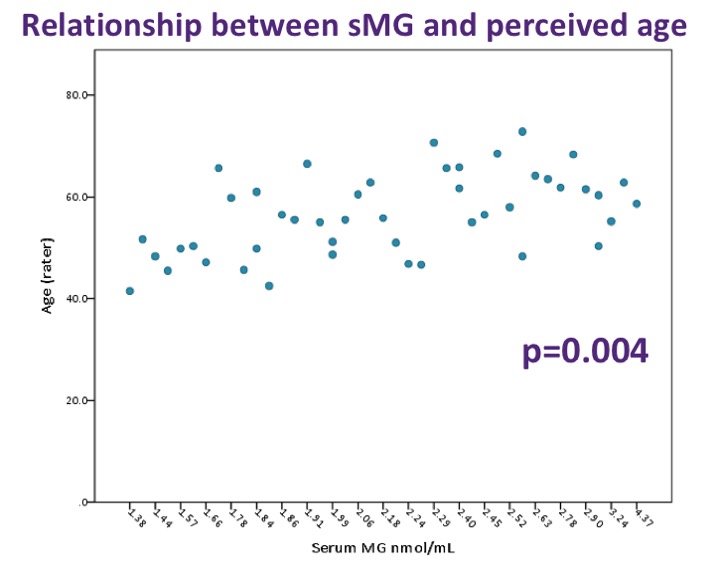Perceived facial aging: The role of AGEs (Advanced Glycation Endproducts)
Elizabeth H. Weissler1, Jonathan Y. Lee, MD, MPH2, Yan W. Ho, MD2, Peter J. Taub, MD, MPH1.
1Icahn School of Medicine at Mount Sinai, New York, NY, USA, 2University of Pittsburgh Medical Center, Pittsburgh, PA, USA.
Background: Advanced glycation end products (AGEs) are a diverse group of macromolecules that are formed during the nonenzymatic glycation of proteins, lipids, and amino acids. High levels of AGEs can contribute to pathologic changes in all tissues, including skin. Elevated levels of AGEs can result from endogenous and exogenous exposures; however, aging and diet are the main contributors. The authors aimed to assess whether serum levels of two AGEs, serum n-carboxymethyllysine (sCML) and serum methyl-glyoxal (sMG), were associated with perceived facial age.
Methods: Patients 50 years of age or older and diagnosed with metabolic syndrome were recruited. A 5-view, standardized set of facial photographs for each patient was evaluated by a group of physicians specializing in facial rejuvenation (two plastic surgeons, two facial plastic surgeons, two dermatologists, and one oculoplastic surgeon). Raters assigned facial aging points in five anatomic areas using a validated facial grading scale. Raters also assigned a numeric perceived age for each patient. Patient serum levels of CML and MG were obtained. Patients receiving any form of facial rejuvenation intervention (injectable filler/neurotoxin, facial surgery) were excluded. Statistics included Pearson correlations, independent t-tests, chi-squared tests, and a multivariate regression consisting of factors found to be significant (p<0.05) on univariate analysis.
Results: Forty-six patients were included, of which 65.2% were female. Twenty-two (47.8%) were Caucasian, 15 (32.6%) were Black, and 7 were (15.2%) Hispanic. The average patient BMI was 32.3±5.7 and average age 61.5±6.9 years. Caucasian patients were older than non-Caucasian (63.6 versus 59.5 years, p=0.044); however, no difference in age was found among gender (independent t test p=0.619) or BMI (correlation p value =0.718). There was a positive correlation between sCML and sMG (coefficient of 0.823, p<0.0001). There was no correlation between actual age and sCML (p=0.786) or sMG (p=0.923). Interestingly, there was a significant positive correlation between perceived age and both sCML (coefficient of 0.542, p<0.0001) and sMG (coefficient of 0.417, p=0.004). There was no correlation between total facial aging points and sCML (p=0.963), sMG (p=0.901), perceived age (p=0.322), or difference between actual and perceived age (p=0.205). However, sCML was the only significant variable
in a regression predicting perceived age that accounted for race, sCML, and sMG: each unit increase of sCML was associated with 0.62 increased perceived years of age (p=0.003).
Conclusions: Multiple pathophysiologic changes influence the perception of the aging face, which may not be fully appreciated by current facial grading scales. Serum AGEs are positively correlated with increasing perceived facial age. Additionally, lower levels of sCML are associated with a perceived age younger than the actual age. AGEs are heavily influenced by environmental factors (ultraviolet light, diet, tobacco use); therefore, reducing these environmental exposures and lowering serum AGEs may provide significant facial rejuvenation. 

Back to 2017 Program




